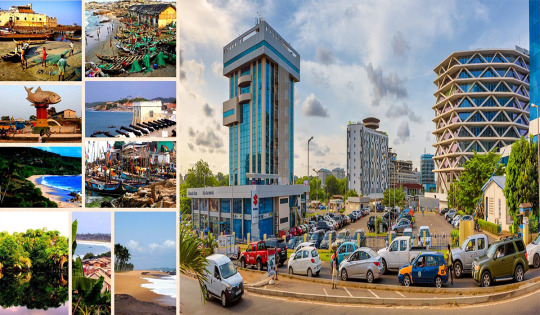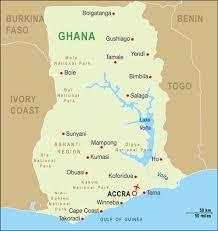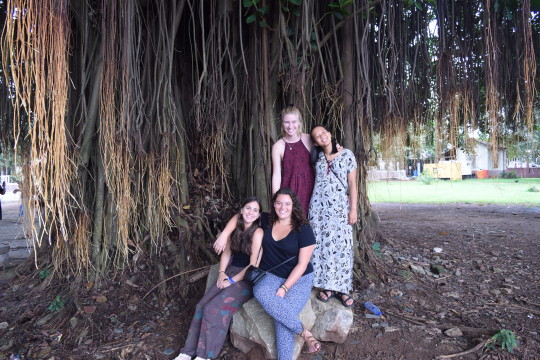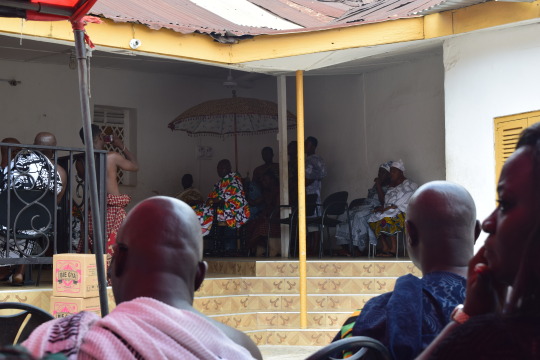#BONWIRE KENTE WEAVING VILLAGE
Explore tagged Tumblr posts
Text
XPLORALYA: HISTORICAL MONUMENTS & UNFORGETTABLE PLACES in GHANA
XPLORALYA: MONUMENTOS HISTÓRICOS & LUGARES INOLVIDABLES en GHANA Suleiman Abdallah Business Administration, Turismo & Viajes, Actor, Writer. Director Gral. GHANA La Agencia Mundial de Prensa. Prensa Especializada Ghana is a historic country with a deep-rooted culture and diverse natural attractions that place it in a privileged position on the Gulf of Guinea in West Africa, famous for its…

View On WordPress
#AFRICA#AKAA FALLS#BONWIRE KENTE WEAVING VILLAGE#DR. KWAME NKRUMAH MEMORIAL PARK AND MAUSOLEUM#ELMINA CASTLE#GBEWAA PALACE#GHANA#HISTORICAL MONUMENTS & UNFORGETTABLE PLACE IN GHANA#lomasleido#Suleiman Abdallah#THE LARABANGA MOSQUE#THE MOLE NATIONAL PARK#XPLORALYA
0 notes
Photo

The Akan culture is highly non-verbal. The Akan communicate through their clothes (Adinkra cloth and Kente), through their dance (Adowa) or through their drums (drumology: art to communicate with drums).This reality required people to learn the symbols, the dance steps, the drum beats in order to understand the messages that were sent out. Today, only few of the young generation understand the gesture and the mimic of the Adowa dancer. Few of us are versed in drumology. However, we know that our Kente cloth were reserved for royalty. Kente is a hand-woven cloth that was only worn by the King and its notables. Today, it is worn by all, especially for celebrations. It originates from the Asante Kingdom (Ghana). The legend says that two brothers Kurugu and Ameyaw from the Bonwire village were on their way to hunt when they saw a spider weaving its web. They were so fascinated by the complexity and the beauty of the spiderweb that they decided to reproduce it with some raphia branches. They offered the product of their work to their King who was amazed. Today, Kente is made of cotton and silk. It is woven by men exclusively. The colour of the kente as well as the patterns in the cloth have a precise meaning. The golden stool pattern for example represents absolute power. The zigzag pattern represents the ability to withstand hardships. The main colours of Kente are gold (royalty, wealth) yellow (royalty, preciousness), white (purity, festive occasions), green (growth, spiritual growth), purple (femininity, spirituality), blue (peace, harmony, love), red (blood, death), brown (mother earth, healing), black (maturity), silver (peace, joy), pink (feminine qualities). Weaving Kente is a traditional savoir-faire. The current mass production of Kente is a threat to our tradition as it leads to a loss of cultural knowledge. To tackle this challenge, Aflé Bijoux will donate a percentage of the sales of the Adinkra collection to the National Folklore Board of Ghana to support their work in the preservation of our Akan heritage. It is our obligation to preserve our heritage in order to pass it on to the next generation. @folkloregh https://www.instagram.com/p/B-ztBQWHHv4/?igshid=1vju6ecv56j2b
0 notes
Text
Ashante Region
9/10/17
We had our first organization-sponsored trip this weekend. We left early-ish on Friday morning for Kumasi, a large city in the Ashante Region of Ghana, which is pretty much dead center within the country. It was really nice to get out of the Accra region for a few days and see some new scenery and shake up our routine a bit, and we were able to do so much in the time we were there.

On Friday, we arrived near Kumasi around lunch time, and then were able to visit several sites to learn more about the Ashante region and the Asante people who live there. We visited one of the only palaces preserved from before the British-Asante wars in the 1800’s and learned more about the Asante people pre-colonialism. The wars went back and forth between who won and who lost, and it’s interesting because the British believed in the end they won, and the Asante believe they came out on top. These wars were fought in part over the Golden Stool of the Asantes, which is said to have descended from the heavens to the first King of the Asantes. Since then, it has become a very important symbol of the people and the region, something that brings them together and is worth fighting for. The British decided they needed the Golden Stool, thought they likely had no idea how much it was worth to the people they tried to steal it from (or if they did, I think that perhaps makes it even worse). The wars were fought, and the British never succeeded in stealing the stool. However, many of the original structures in the region were destroyed—only 10 original buildings still stand, and we were fortunate enough to visit one.
Something our tour guide mentioned that I thought was so incredible is that a major method of communication between Asante villages was drums. He told us that the sound of the drum could reach up to six kilometers away, so a message from Kumasi could reach what is now the Ivory Coast in 15 minutes. How amazing is that? Isn’t there a scene in the Lord of the Rings like that? Well, the Asantes did it first.
We then drove to the part of the region where the famous kente cloth originated, a village called Bonwire. Kente is absolutely beautiful—intricately woven patterns and vivid colors, no two pieces are the same, even if they have the same pattern. We were even able to see some of the weavers at work (mostly men, because it was believed until recently that it was bad luck for women to weave), and it is mesmerizing. Each pattern has a meaning, which is especially important if you are getting the cloth made into clothing. Some of the patterns seemed like staples, signifying things like “Family is unity,” and “Two heads are better than one,” but some really surprised me—Bill Clinton and Barrack Obama each have a pattern named after them. Really? Clinton?
After buying my fair share of cloth and escaping the massive amount of people grabbing our hands and showing us their goods, we moved on to the village where the adinkra symbols originated. A very special ink is used to stamp the symbols on cloth, so we got to see some of the process of making the ink. The bark from the badia tree is gathered—the tree itself lives—and is soaked in water for several days, then pounded, then boiled and strained out of the liquid left after boiling. Finally, this liquid, relatively thin at this point, is boiled down further to make a thick black ink. The badia tree sounds like something I definitely would want growing in my back yard—besides the ink, the bark can be used to cure diarrhea and menstrual cramps. Cool, right? All in one fabulous tree. And how cool that people figured this out, all these uses. Mmm.
Our organization purchased a long cloth for us so that each person in our group could stamp their symbol of choice into permanence. I chose a fancy heart, which I believe is one of the versions of Sankofa, and was told that it means staying grounded, returning to your roots, and learning from your past to build your future. I think that for a lot of the symbols it depends on who you ask, though the same root idea is threaded through all of the answers.

Ooo also! While we were there, a group of children found us (not rare because our groups draws a lot of attention barreling around in a bright red tour bus filled with Americans), and one of the boys asked me how old I was. I told him to guess, and he looked up at the sky and screwed up his face and really thought about it, and then looked at me and confidently said, “Twenty.” I was so excited, I mean what are the chances he got it dead on!!! (I understand that the chances were actually pretty good, but still.) He puffed out his chest and said, “I am superman!” I don’t know, it just made me laugh and reminded me of my campers from this summer, it was pretty cute.
This was quite a full day, so we were all feeling ready to check into our hotel. We had a delicious dinner (pizza was involved, which is expensive to buy yourself, so I was pumped), and then checked out the bar and outdoor pool. It was so nice to just have some time to unwind and enjoy the night. After swimming for a while, I took a HOT shower!!!! For the first time since I left (I really don’t mind the cold showers because it’s so warm outside, but I will NOT say no to a hot shower). Pampered. It was lovely.
On Saturday morning, we toured the old palace of the King, which is now a museum. It was really interesting to hear more about how the royalty functions, although I still am unclear how it works within the larger Ghanaian government. From what I did learn: There is a King and a Queen Mother, and the Queen Mother and King can never be married. Usually, she is his mother, sister, aunt, or other female relative. The Queen Mother is very important—it sounded to me like she had more power than the King. The Asantes have matrilineal inheritance, so the King’s son will never be King, but the Queen Mother’s son might be. This is because it is impossible to prove who the father of any child is, but you always know the child is related to their mother, the blood of the King will always be pure.
The Queen Mother elects a man from the royal family who she thinks is fit to be king, and then after several screening processes, he may be crowned. If ever he makes a mistake or behaves in an un-kingly manner, the Queen Mother has the power to dethrone him at any time, without anyone else’s permission. That’s it, he’s done. The women of the Asantes also were regarded as very powerful and respected warriors, and the woman who was Queen Mother during the beginning of the British wars I mentioned earlier was an incredible war leader. Badass.
After our tour, we drove to the largest market in West Africa. The largest. I’ve been to several markets in my time here (it’s officially been one month, by the way!), and all of them have overwhelmed me in one way or another, but this one was insane. Insane. So many people. So many things. People shouting, people shoving you into traffic (not on purpose, but not not on purpose, ya know?), fish, meat, piles of clothing, all the usual, but so many times larger. And it was hot. I thought I could handle it, but 20 minutes in I honestly was almost in tears I was so overwhelmed. I’m not even sure how to describe how busy it was. I don’t think I would even have been able to buy anything because if you try to stop at a shop, you’ll just get carried away by the crowd pushing you. At least that’s how I felt. I’m sure some people thrived, but I’m happy enough to say I survived.
There is a festival going on in the Ashante region currently, so today (Sunday) we were able to see a ceremony with the current King, and even meet one of the chiefs (who, from my understanding, functions as protection for the king). It was really humbling—we were surrounded by royalty, essentially.
Midday, it was time to head home to Accra. About an hour outside of Kumasi, our bus broke down, which was kind of a bummer, BUT then about 15 minutes later, another bus drove by and picked us up. How amazing is that? Sweet serendipity. Still, it took about 6 hours for us to get home when it typically would take about 4. I listened to about one billion podcasts, so I was happy. And now, I’m all showered and settled back in to start school again tomorrow. It’s nice that our hostel now feels like a home to me, something familiar and welcoming to come home to.
P.S.Something to look into: You know when you’ve never heard of something before, and then you learn about it, and then it pops up other places and it’s so COOL? So in Kumasi, we learned about the adinkra symbols, and one of them is Sankofa, and then I was listening to a podcast on the way home from Kumasi and they mention Sankofa!!! How cool is that? Anyways! It was an excellent episode of This American Life about Afrofuturism. Highly recommend, and let me know if you have thoughts on it you’d like to discuss!
Here are some photos-- I didn’t take a lot because there were many occasions it would have been disruptive, but trust that it was very beautiful.

This tree reminded me of that tree in Avatar. It was magnificent and ginormous.



This is one of the Chiefs of the Asante people, who we were able to meet and greet individually. He also bought us lunch.

From the Adae Festival

2 notes
·
View notes
Text
Day 9: May 16th in Kumasi
Kumasi is the center of the Ashanti Kingdom, home to the Ashanti people, which is the main cultural group in Ghana. Our day will be spent learning about the Ashanti culture through exploring the Central Market (as known as Kejetia Market) and the Ashanti Craft Village. At the Craft Village I especially look forward to taking in the making of the traditional Kente Clothe in the Bonwire weaving village.
After our day of exploring we will journey to Mole International Park where we will retire to peaceful rest at the Mole Motel in preparation of adventuring through the park the next day.
The traditional Ashanti culture is an important aspect of Ghana that I want to experience in my time there. The previous stops on my journey have all been exploring more touristy and commercialized places in Ghana, and this will serve as a way to see the traditional Ghanaian culture.
0 notes